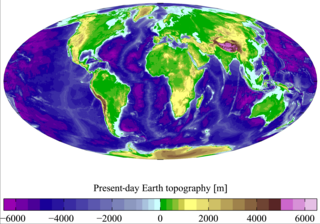Geology of solar terrestrial planets
The terrestrial planets all have roughly the same structure: a central metallic core, mostly iron, with a surrounding silicate mantle.
[1] Three of the four solar terrestrial planets (Venus, Earth, and Mars) have substantial atmospheres; all have impact craters and tectonic surface features such as rift valleys and volcanoes.
The Solar System is believed to have formed according to the nebular hypothesis, first proposed in 1755 by Immanuel Kant and independently formulated by Pierre-Simon Laplace.
[2] This theory holds that 4.6 billion years ago the Solar System formed from the gravitational collapse of a giant molecular cloud.
They coalesced into larger objects, forming clumps up to a few kilometers across in a few million years, a small time in comparison to the age of the Solar System.
[3] After the planetesimals grew bigger in sizes, collisions became highly destructive, making further growth more difficult.
[3] After the protoplanet formed, accumulation of heat from radioactive decay of short-lived elements melted the planet, allowing materials to differentiate (i.e. to separate according to their density).
[3] In the warmer inner Solar System, planetesimals formed from rocks and metals cooked billions of years ago in the cores of massive stars.
[13] Such relations strongly support a volcanic origin for the mercurian smooth plains, even in the absence of diagnostic landforms.
These ridges probably were formed by local to regional surface compression caused by lithospheric loading by dense stacks of volcanic lavas, as suggested for those of the lunar maria.
There is debatable evidence of active tectonics in the planet's distant past; however, events taking place since then (such as the plausible and generally accepted hypothesis that the Venusian lithosphere has thickened greatly over the course of several hundred million years) has made constraining the course of its geologic record difficult.
This research has led to the fairly well accepted hypothesis that Venus has undergone an essentially complete volcanic resurfacing at least once in its distant past, with the last event taking place approximately within the range of estimated surface ages.
While the mechanism of such an impressionable thermal event remains a debated issue in Venusian geosciences, some scientists are advocates of processes involving plate motion to some extent.
The planetary surface undergoes reshaping over geological time periods due to the effects of tectonics and erosion.
Surface features built up or deformed through plate tectonics are subject to steady weathering from precipitation, thermal cycles, and chemical effects.
Glaciation, coastal erosion, the build-up of coral reefs, and large meteorite impacts[20] also act to reshape the landscape.
As the continental plates migrate across the planet, the ocean floor is subducted under the leading edges.
The most abundant silicate minerals on the Earth's surface include quartz, the feldspars, amphibole, mica, pyroxene, and olivine.
[29] The geological history of Earth can be broadly classified into two periods namely: The surface of Mars is thought to be primarily composed of basalt, based upon the observed lava flows from volcanos, the Martian meteorite collection, and data from landers and orbital observations.
[30] Analysis of the soil samples collected by the Viking landers in 1976 indicate iron-rich clays consistent with weathering of basaltic rocks.
[30] There is some evidence that some portion of the Martian surface might be more silica-rich than typical basalt, perhaps similar to andesitic rocks on Earth, though these observations may also be explained by silica glass, phyllosilicates, or opal.
Also, some characteristics of its surface and history (such as its distance from the Sun, which weakened solar radiation enough to allow some fairly low-freezing-point components to be incorporated during its formation), point to the presence of volatile materials in the interior of Ceres.
The ubiquitous features of the Cererian IR spectra are those of hydrated materials, which indicate the presence of significant amounts of water in the interior.
High-resolution ultraviolet Hubble Space Telescope images taken in 1995 showed a dark spot on its surface, which was nicknamed "Piazzi" in honor of the discoverer of Ceres.
More recent visible-light Hubble Space Telescope images of a full rotation taken in 2003 and 2004 showed 11 recognizable surface features, the natures of which are currently unknown.
These last observations also determined that the north pole of Ceres points in the direction of right ascension 19 h 24 min (291°), declination +59°, in the constellation Draco.
Surface water ice is unstable at distances less than 5 AU from the Sun, so it is expected to vaporize if it is exposed directly to solar radiation.
It may be possible to detect escaping water from the surroundings of a fresh impact crater or from cracks in the subsurface layers of Ceres.
Asteroids, comets, and meteoroids are all debris remaining from the nebula in which the Solar System formed 4.6 billion years ago.
[39][40] Like the asteroid belt, it consists mainly of small bodies (remnants from the Solar System's formation) and at least one dwarf planet—Pluto, which may be geologically active.












